2022.12.16
CULTUREIn the Footsteps of TEZUKA Osamu, the “Manga Ambassador” Who Continues to Captivate the World with His Outstanding Foresight and Creativity
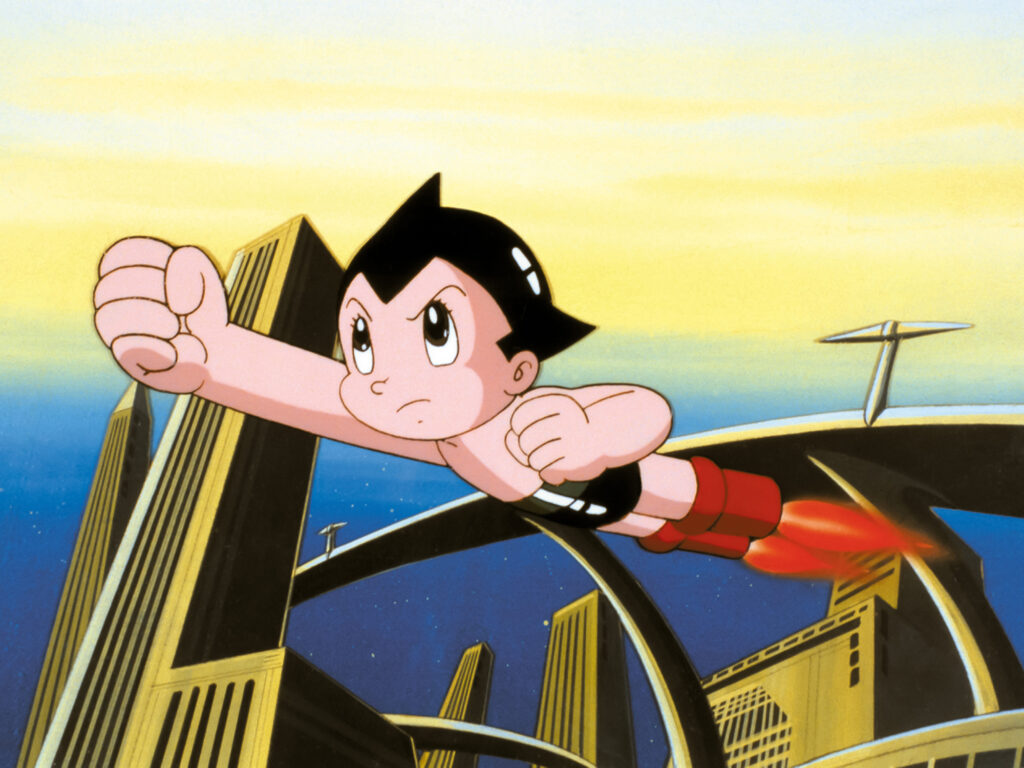
The TV animation series “Astro Boy” began airing in black and white in 1963, and a color version was broadcast in 1980. Since then, the series has been remade several times. Photo: 1980 ASTRO BOY ©Tezuka Productions
Japanese manga and animation are popular all over the world and are helping more and more people to connect with each other. The foundation for this exchange was laid out by TEZUKA Osamu. We trace Tezuka’s belief that one day manga would become an “international language.”
Manga and animation now fascinate people around the globe and play a major role in cultural exchange between Japan and the rest of the world. One of those who laid the foundation for this was TEZUKA Osamu. Universal themes, drawings that appeal to everyone, and stories that thrill readers—the world created by Tezuka’s outstanding creativity transcends linguistic and cultural differences, capturing people’s hearts.
Tezuka had deep connections with foreign countries, and he himself was deeply interested in other cultures. “Astro Boy” was first broadcast on NBC in the U.S. in 1963—the same year it was initially aired in Japan—and became a pioneering leap forward for Japanese animation around the world. Tezuka also actively participated in lectures, international animation festivals, and comic conventions. In 1980, he was dispatched by the Japan Foundation (JF) to the United States with SOEDA Yoshiya, Professor of the University of Tsukuba at that time, who was also a sociologist and manga critic. Beginning with a lecture at the United Nations Headquarters in New York, he traveled to universities and halls in Princeton, Chicago, San Francisco, and Los Angeles. He gave lectures on Japanese manga and held screening sessions of his own anime works.
In 1984, Tezuka was sent by JF to Brazil to give lectures in São Paulo, Manaus, and Rio de Janeiro, where he met the maestro of Brazilian comics, Mauricio de Souza. The two hit it off so well that when Souza came to Japan, Tezuka personally welcomed him at Narita Airport. Later, they became so close that they started visiting each other’s homes, and even promised to make an anime together, but this promise was not fulfilled due to Tezuka’s death. MATSUTANI Takayuki, President of Tezuka Productions Co., Ltd., recalls, “Mr. Tezuka very much cherished the interactions he had with people from overseas. He kept saying, ‘Manga and anime transcend national borders,’ and he wanted to convey the tragedy of war and the importance of peace through his works.”
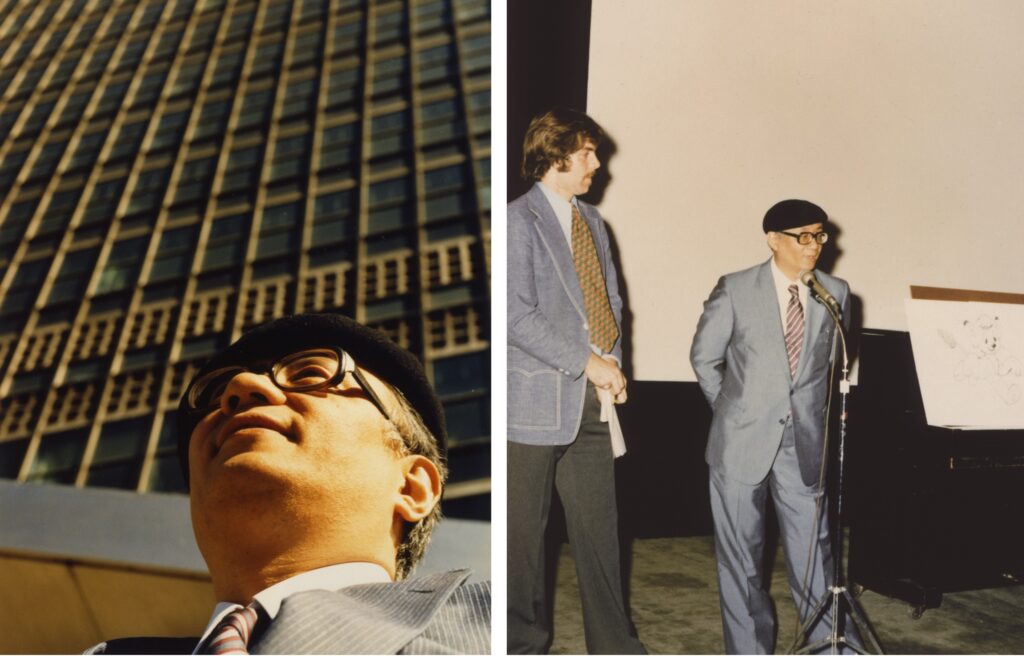
In 1980, Tezuka was sent by JF to visit the United States. He gave lectures at the United Nations Headquarters and other locations. The photo on the right shows Frederik L. Schodt, an interpreter at the time, standing on the left of Tezuka.
Tezuka’s Keen Eye, Seeing Far into the Future
Frederik L. Schodt was the interpreter for many of the U.S. lectures in 1980. Schodt, who has long introduced Japanese manga overseas as a writer, translator, and interpreter, first encountered Tezuka’s manga in the 1970s when he was studying at International Christian University in Tokyo. He was fascinated by the manga Hinotori, or Phoenix, which he borrowed from a friend. Years later, a visit to Tezuka Productions to inquire about translating Phoenix into English was the beginning of a close relationship with Tezuka. “I was one of Mr. Tezuka’s main interpreters and coordinators during his visits to the U.S. from around 1979,” says Schodt. “Among other things, he attended a pop culture festival called ‘Comic-Con International: San Diego’ and visited Disney World in Florida. I think the U.S. played a major role in Tezuka’s mind. The U.S. was the first overseas country to recognize his works. At the time, Tezuka also was one of the few Japanese manga artists who had fans overseas. I’m sure he thought of himself as a goodwill ambassador to the world via comics.”

Frederik L. Schodt. Born in 1950. In addition to translating and co-translating the works of TEZUKA Osamu and many other Japanese manga artists, Schodt has contributed to the expansion of Japanese manga abroad through his writings, lectures, and interpretation, sparking a worldwide manga boom. He received the 4th Tezuka Osamu Cultural Prize Special Award in 2000 and the Order of the Rising Sun, Gold Rays with Rosette in 2009. Schodt is also a 2017 Japan Foundation Award recipient. © Frederik L. Schodt
In 2002, an English version of the manga “Astro Boy,” translated by Schodt, was published. “In translating all 23 volumes of ‘Astro Boy,’ I found myself amazed by Tezuka’s ability to see into the future,” Schodt says. Even though in the manga storyline Atom was born in 2003 —essentially in our time— Tezuka had foreseen what our world might be like, long, long before that.”
Schodt sums up the appeal of Tezuka’s works, saying, “Tezuka was unique among Japanese manga artists. He was a licensed physician, well versed in foreign literature, and he had seen a huge number of French, German, and American films. This gives Tezuka’s stories a universality that makes them accessible to foreign readers. Also, ‘Astro Boy’ is a good example of how many of his works, while initially created for children, have stories that are by no means trivial. While ‘Astro Boy’ is a manga about a 10-year-old boy robot, written for children in the 1950s and 1960s, it has themes pertinent to issues facing modern society today, such as suicide bombers, AI, and environmental destruction. Tezuka always said that if he had to draw a story, he had to be interested in it; otherwise he couldn’t keep drawing it; even if drawing for commercial purposes, he had to enjoy himself. It was his intellect and the breadth of his innate interests and his enjoyment that made him unique.”
With JF funding, Schodt published a book on Japanese manga called “Manga! Manga! The World of Japanese Comics” in 1983. In 2016, he published “The OSAMU TEZUKA Story,” an English translation of the Japanese manga by the same name. On the other hand, he is also active in fields other than manga, translating novels by SHIINA Makoto and SHIMIZU Yoshinori, and publishing works on the history of cultural exchange between Japan and the U.S. For his series of accomplishments, he was selected as one of the recipients of the Japan Foundation Awards in 2017.
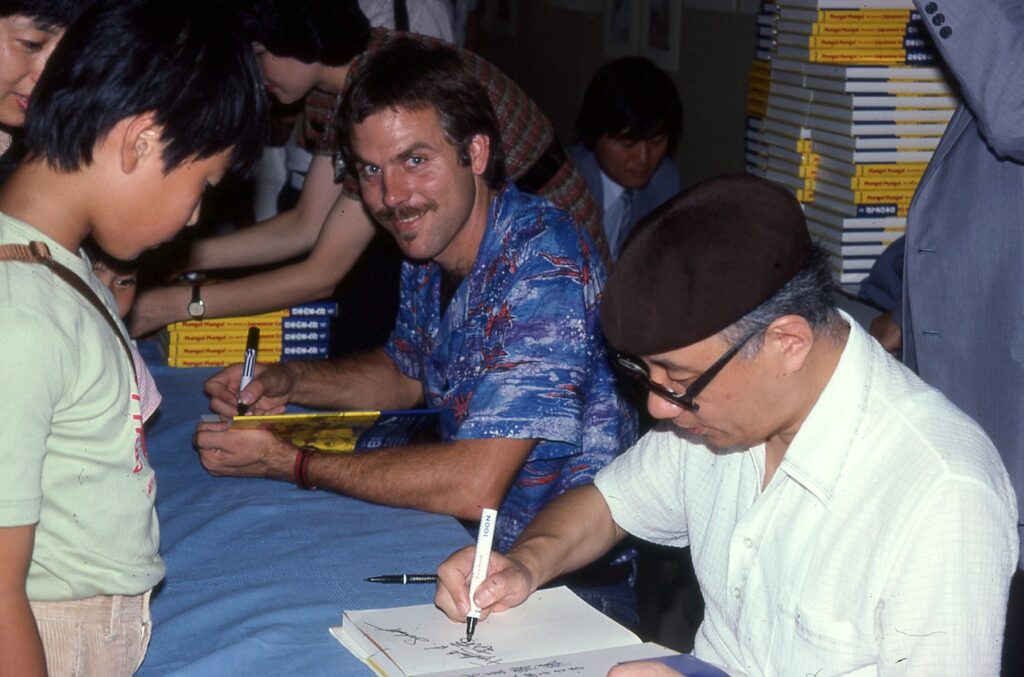
In 1983, when Schodt held a book signing for “Manga! Manga! The World of Japanese Comics,” Tezuka, who contributed the foreword to the book, was also present. © Frederik L. Schodt
Why Astro Boy Continues to Be Loved
One of the great charms of Tezuka’s works is that they do not fade in popularity over the years. President Matsutani says, “The most popular of Tezuka’s anime overseas are ‘Astro Boy,’ ‘Jungle Emperor Leo’ and ‘Princess Knight,’ among others. ‘Astro Boy’ aired in the U.S. in 1963 in black and white and was followed by the 1980 color TV anime series of the same name in Asia, Europe and the United States. Those who watched it later became buyers of anime overseas or came to international anime and manga conventions.”
While “Astro Boy” has been renewed for TV anime series and movies both domestically and internationally, SUZUKI Yoshimi, a producer at Tezuka Productions says, “From around 2003, people who grew up watching ‘Astro Boy’ became involved in its production overseas.” Suzuki also says, “European and Asian creators played a key role in the creation of 2019’s ‘GO ASTRO BOY GO!’ It is the first ‘Astro Boy’ TV anime series to target four- to six-year-old children and also dealt with environmental issues. In the process of remaking ‘Astro Boy,’ both the production site and the content continue to evolve on a global scale.”
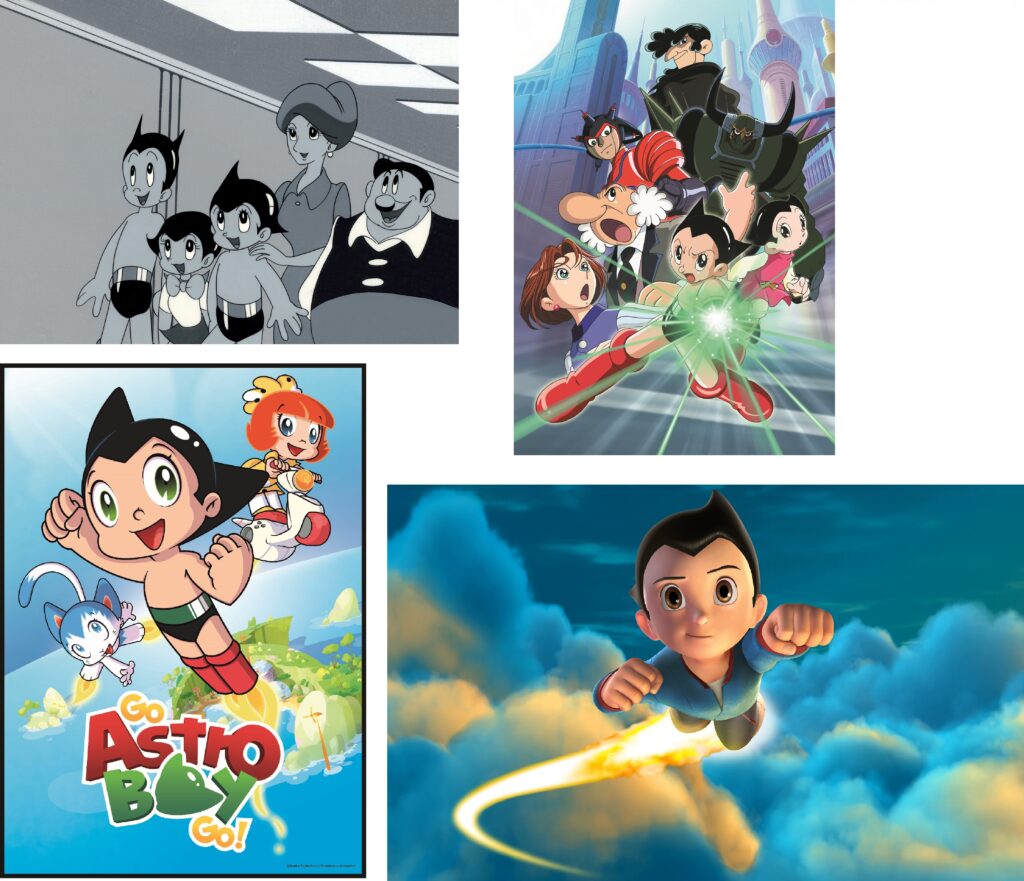
“Astro Boy” has been loved throughout the ages. Clockwise from top left: 1963 ASTRO BOY ©Tezuka Productions (TV series), 2003 ASTRO BOY ©Tezuka Productions/SPEJ (TV series), 2009 ASTRO BOY ©Imagi Crystal Limited (film), 2019 GO ASTRO BOY GO! ©Tezuka Productions (TV series)
The fact that “Astro Boy” has been loved for such a long time is not only due to the charm of the work, but also to the fact that the anime has been broadcast in dubbed versions in local languages in various countries and regions around the world. Suzuki explains as follows, “There are many older Japanese animated films that are entertaining and of high quality for children. Such works are in high demand in emerging countries, but economic problems have made it difficult to broadcast them. This is because the cost of localization (mostly translation from the English version into each language, followed by post-recording) and the cost of converting the material to that required by each region are high. Therefore, it was going to be difficult to make it work as a business unless a regional distribution company intervened to some extent and discussed the business development not only in terms of images, but also copyrights. The Japan Foundation’s Film and Broadcast Media Department solved the above issues. We were able to offer our works to overseas broadcasters where children could view them, and also the producers received support for the usage fee. We are very grateful to them for providing us with a scheme that meets the needs of both parties and supports our business and our works.”
What is the Hidden Potential of Japanese Manga?
More people are becoming interested in learning Japanese through exposure to Tezuka’s works and other Japanese manga and anime that have been translated, broadcast, and distributed around the world. According to the Survey on Japanese-Language Education Abroad, conducted by JF every three years, Japanese pop culture, including manga and anime, has been the number one motivation for learning Japanese around the world in 2015 and 2018.
Tezuka’s works are also now considered a part of Japanese art. In 2021, JF co-organised the “Rimpa feat. Manga” exhibition with the Museum Fünf Kontinente, Munich, Germany. Tezuka characters such as Atom and Black Jack appeared in scenes from famous Rimpa and Jakuchū paintings, gathering a great deal of attention as a completely new “contemporary Japanese painting” exhibition. (An additional exhibition was held at the Hosomi Museum in Kyoto from September 6th to December 4th, 2022.)
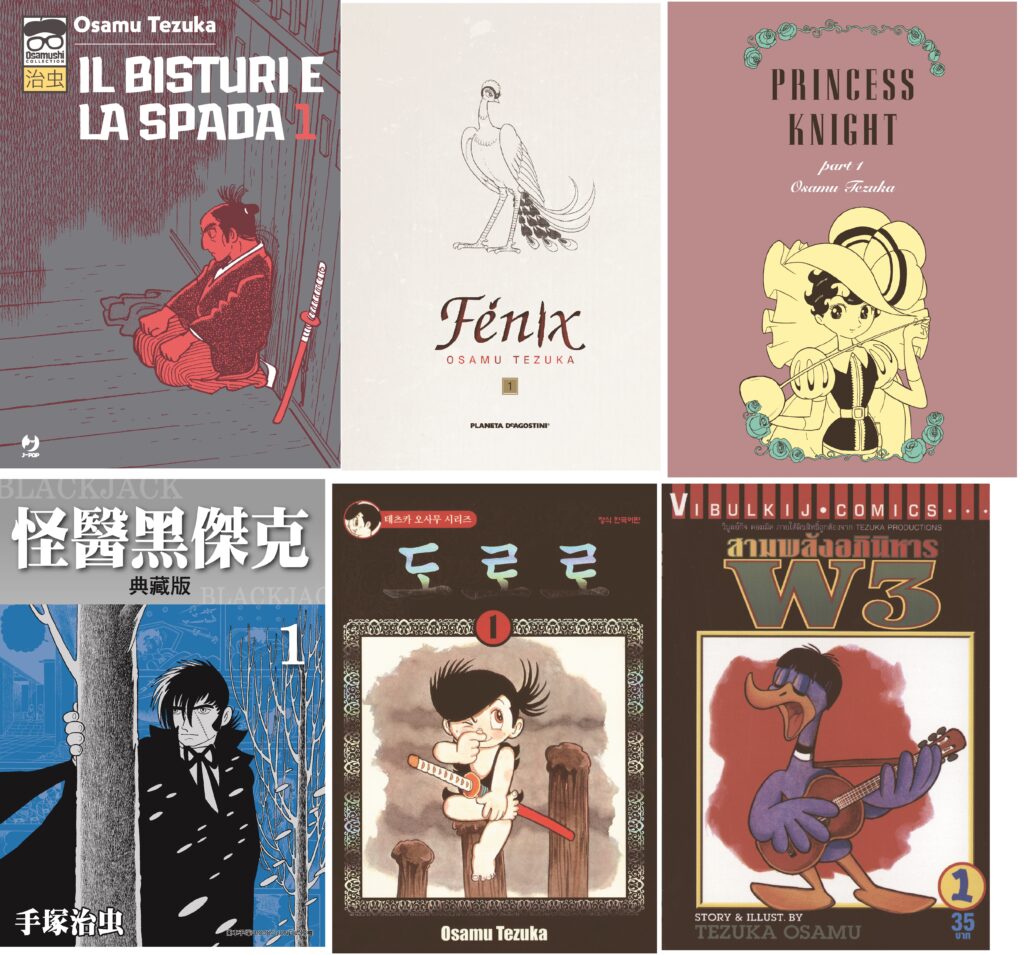
Tezuka’s manga has been translated and is popular in many countries around the world. Clockwise from top left: Italian Version of “A Tree in the Sun,” Spanish Version of “Phoenix,” English Version of “Princess Knight,” Thai Version of “W3(Wonder 3),” Korean Version of “Dororo,” Traditional Chinese Version of “Black Jack.” Photos: ©Tezuka Productions
The Ministry of Foreign Affairs established the Japan International Manga Award to honor artists who contribute to the promotion of manga culture overseas. Schodt, who serves as a member of the Executive Committee of the award, discusses the potential of manga by saying, “Most of the candidates were influenced by Japanese manga in one way or another. Manga have become the world’s ‘MANGA,’ and I believe that JF has done a great job in helping to promote Japanese manga to the world. It is a genre through which people from all over the world can interact with each other.”
In the preface to Schodt’s book “Manga! Manga! The World of Japanese Comics,” Tezuka writes the following: “My experience convinces me that comics, regardless of what language they are printed in, are an important form of expression that crosses all national and cultural boundaries, that comics are great fun, and that they can further peace and goodwill among nations. Humor in comics can be refined and intellectual, and it has the power to raise the level of all people’s understanding. I believe that comics culture will continue to grow and develop.” It has been 33 years since Tezuka passed away. True to Tezuka’s wish, Japanese manga and anime have developed into an “international language,” attracting an interest in Japan among people around the world and serving as a force for promoting communication.
【Related pages】
Drama, Animation, Documentaries . . .Sharing the Spirit of Japan with the World through TV
Three Exhibitions Opening Up New Dimensions; Japanese Art and Architecture as Perceived by Overseas Curators
Learning Japanese Changed My Life—A Passport to the Future Gained through Japanese Language Learning
American Scholar Revealed the Profound World of The Tale of Genji
